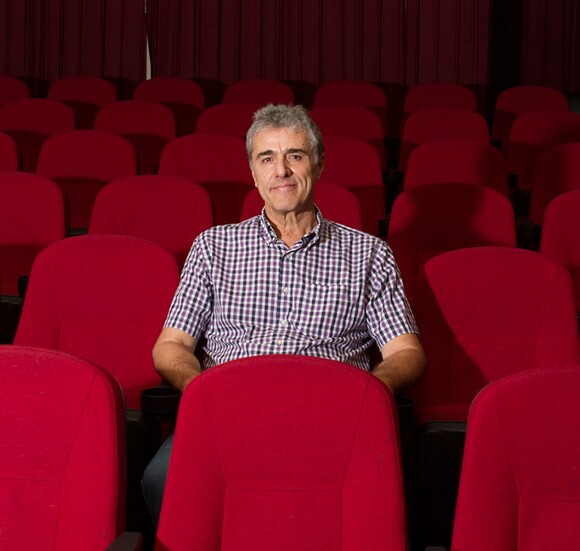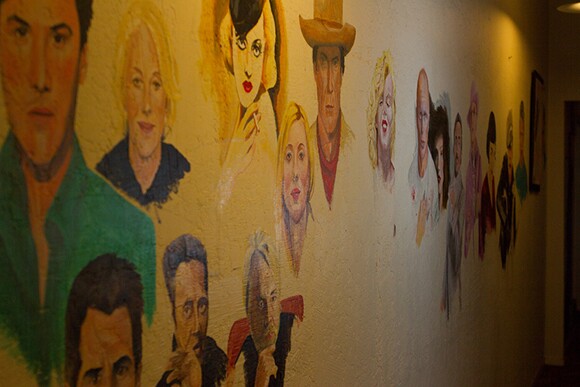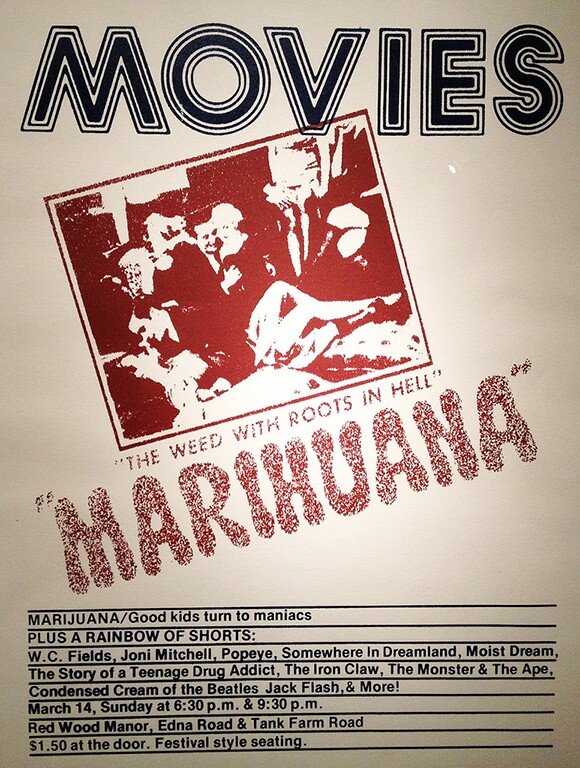The Palm Theatre and the Man Behind the Reel

In a world where moviegoers pay upwards of $15 dollars just for one ticket, a hero has risen. Jim Dee embarked on a journey to change the landscape of cinema on the Central Coast forever. He established a rare gem of a movie theater with admission prices under two digits and popcorn for a dollar -- where an eclectic mix of independent, foreign, and documentary film collide.
Dee is the proprietor of this much beloved San Luis Obispo independent art-house, the Palm Theatre. He has held a passion for "alternative repertory theater" culminating from his college days attending Cal Poly, where he promoted his homegrown and unique film society titled "Cinema Zoo." Along with fellow student Paul Karlen in 1972, Dee spearheaded Cinema Zoo showing 16-millimeter indie cult classics around campus and in San Luis Obispo. With the 75 cent admission price, exoteric fair and eye-catching poster designs, cinephiles lined up for the opportunity to experience low-tech cinema in experimental places.
Possessing a deft cinematic touch and encyclopedic knowledge of all things film, Dee along with his wife Patty, have entertained San Luis Obispo moviegoers for decades -- screening thousands of movies outside the major studio rotation. Paging through his yellowed scrapbooks, which document his devotion to film, Dee corroborates, "35 years, geez that's a lot of movies."


Dee moved to California by way of New Jersey as a child. His creative roots point to his musical parents. Dee's father, Giacomo DePasquale was born in Caltagirone, Sicily and immigrated to the United States by way of Ellis Island in 1912 as a young boy. Dee's father taught music at the Institute of Musical Arts, which would later become The Juilliard School. His parents met as Dee's father was giving his mother an accordion lesson. Together they navigated the many obstacles of the immigrant experience. "My dad changed his name by design early in his career. He wanted to sound more American and his students couldn't easily pronounce DePasquale. The students began calling him by a nickname, 'Mr. Dee' and it just stuck," recalled Dee.
The Jazz records Dee's father would bring home along his mother playing Chopin to lull him to sleep ingrained a life-long love of music and the arts. Dee's last memory of his father before his death in 1970 was bearing witness to his father's passion for music. "It was a wonderful memory. I was doing homework and dad was playing beautifully on our piano," recalled Dee. "He was making it up off the top of his head." Dee continued, "Growing up it was like a Norman Rockwell painting where every living room had a piano. Our house was like that. My mother on the piano -- she was an amazing sight-reader, and my dad with the Jazz records that I totally dug. The confidence I have as a small business owner comes from my dad. He said 'Do what you love and be your own boss.' His words were life-changing for me."

After attending Cal Poly as a Journalism major and a brief foray in the broadcasting industry, Dee opened his first movie house, The Rainbow in 1979 -- as an offshoot of Cinema Zoo. The Rainbow was San Luis Obispo's first art house movie theater, offering healthy alternative snacks and double features at a very affordable price. "The concept of the name referenced the spectrum in a rainbow, and my aim to provide a spectrum of alternative films," described Dee. "The first film we showed at the Rainbow was Franco Zeffirelli's 'Romeo and Juliet,'" recalled Dee. "And the last film we showed before turning off the lights for good was a double feature, "Harold and Maude" with "King of Hearts." Both trustful cult films I could pull out of my movie house bag of tricks."
Although the 160-seat Rainbow closed its doors in 1989, Dee still hears from locals about its enigmatic effect and the early programming carried on to the Palm. "We would do a film trio of Woody Allen films had patrons would be in seats from 7 p.m. to midnight," he says. "The Rainbow was open those early years Wednesday through Sunday. I had Mondays and Tuesdays off, but later I needed a way to draw people in on a Monday. I created Bargain Night, which became a big hit and a Monday night habit for the town. Patrons would slap two-bucks down and ask 'what's showing?' They didn't bother to even check the schedule. Moviegoers even today have that same mentality at the Palm's Bargain Night."

Wanting to expand, Dee opened The Palm Theatre in 1988 and operated both movies houses simultaneously. Dee recollected that running both theaters was arduous and was a fork in the road for him. "Although at the time the popularity of the Rainbow didn't carry over to the Palm, the cost overhead to run both theaters was enormous," said Dee. "I was sitting in Rainbow thinking my heart and soul is in this place and I have to make it work, but one week later we closed it."
The Palm remains a San Luis Obispo cultural institution; yet opening up the Palm Theatre in 1988 was not without controversy and not without a struggle. "The first five years were a challenge. We had to weather protests over our screening of 'The Last Temptation of Christ' and backlash from Rainbow aficionados who felt the Palm was sterile compared to the exposed brick interior of the Rainbow," said Dee. "My counter-argument to them was that they should be looking at the damn screen instead of the walls!"
Local film-goers were eventually won over with the screening of "Shirley Valentine," playing 20-weeks straight. "That movie was a huge success with only word-of-mouth promotion. There have been several times where patrons create a buzz about a film and tell their coworkers and neighbors to come see a film. No amount of advertising dollars can pay for that type of hype. "Amelie" is another example. "Amelie" remains the longest-playing film at the Palm, playing for over 32 weeks. In 1993 the Palm turned the corner financially with the screening of the film "The Crying Game" and the addition of a third screen.
Radio and Film Careers Collide
Expanding on his childhood fondness for music, Dee jump-started his journey into broadcasting at Cal Poly's independent student radio station; KCPR remains a broadcasting force that has launched numerous careers of Cal Poly Alumni. Dee's experience as a Cal Poly KCPR DJ developed his taste and expertise for World Music and broadcast journalism. Dee started out as a KCPR DJ while still attending San Luis Obispo High School.
"I am still connected to KCPR as an alum and carry with me the teachings of my former journalism professors," reminisced Dee, getting sidetracked and proving the consummate journalist. "What passes for journalism now is just crap. Headlines are purposefully misleading to solicit clicks for ad sales. My Poly professor Jim Hays instilled in me a valuable lesson. I was working hard on story of Bob Kennedy traveling to China and when I turned in the story to Hays I got a flat F. I asked him what happened and he said I didn't have the most important point in the first sentence. He was absolutely correct! Yep, I learned more from that F than any other class or professional experience."
Dee remains active on the local airwaves hosting "Music of the World's People" on the Central Coast public radio station KCBX. It is on the KCBX airwaves that along with local cinéaste Bob Whiteford, Dee launched a radio program called "Take Two," a weekly call-in show for everything film. Dee and Whiteford recently transitioned the series directly to the big screen at the Palm, with "Take Two Live," screening esoteric films and incorporating audience participation with post-screening chats about the film.

"Take Two Live" has a loyal following. On a recent sunny Sunday afternoon regulars lined up early to grab a seat, including artistDavid Settino Scott. "I come to see the banter between Bob and Jim and their philosophical disquisition about what we are watching," described Scott. The series is a marriage of film and conversation that keep moviegoers coming back for more, no matter the subject. On this Sunday, Dee and Whiteford screened "Le Grand Illusion," the 1937 Jean Renoir French war film. They opened up the discussion with their trademark introductions: "Across the aisle from me is the one and only Jim Dee." "And across from me is Bob Whiteford. We're only in it for the movies."
Bringing the "Take Two Live" event indoors and into the theater reinforces Dee's love for his work. "Recently the theater has gone completely digital -- retiring 35mm forever. Sitting down and talking film with our patrons has helped get through that transition. There is something special about sharing a communal film-going experience," said Dee. "The lights go down, you are in a group reacting to not only the film but also the reaction of the person seated behind you...sharing in their sighs and laughter. All the digitalism in the world can't replace that type of experience."
Coming Attractions
The Palm Theatre became the first-ever solar powered movie house in the United States after the installation of 80 solar panels on the roof of his building. Dee received the Environmental Initiative Award from the San Luis Obispo Community Foundation for the Palm's innovative solutions to support the environment. Dee has supported the arts through his confounding of the San Luis Obispo International Film Festival and by hosting movie premieres to benefit local charitable organizations. The Palm also supports local artists through cinematic themed murals and original art showcased throughout the theater. "Dave Norton is a terrific local artist who painted our hallway leading to screens two and three. Whenever he has a lull in work he comes in and adds to the walls," said Dee.
Why does Dee continue? "I consider film and even more importantly the movie theatre experience to be a true art form, from pure entertainment to a poignant and meaningful representation of our humanity. As technology has changed, methods of viewing films has changed, and I want to not only preserve the movie theatre as the best place to enjoy films, but to also showcase world cinema, going far beyond what is offered in the United States."



Dig this story? Sign up for our newsletter to get unique arts & culture stories and videos from across Southern California in your inbox. Also, follow Artbound on Facebook and Twitter.